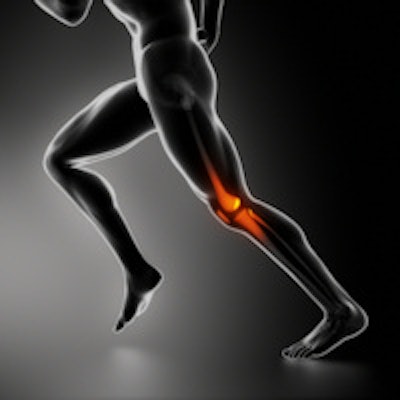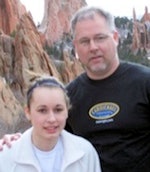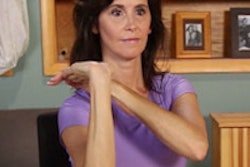
Iliotibial band syndrome (ITBS) is primarily known as one of the most common overuse injuries for runners. But sonographers and other professionals who are on their feet all day also experience problems caused by tight IT bands.
Compared with the upper-body issues (involving the neck, back, shoulders, etc.) that nine out of 10 sonographers experience, IT band problems aren't at epidemic levels. It's definitely a problem area, though.
ITBS occurs when the IT band, the ligament that runs down the outside of the thigh from the hip to the shin, is tight or inflamed. The IT band attaches to the knee and helps stabilize and move the joint. When the IT band isn't working properly, movement of the knee -- and, therefore, movement in general -- becomes painful. In severe cases, IT band pain has sidelined individuals for weeks or even longer.
 Echocardiographer Doug Wuebben and his daughter.
Echocardiographer Doug Wuebben and his daughter.My own IT band issues occur when I scan predominantly right-handed. My right leg often sits or hangs uncomfortably while I perform the scan. There may be too much or not enough support of my upper leg. Frequently, my foot and/or lower leg will go to sleep. This situation has led to the knee issues described in this article.
ITBS symptoms
The most notable symptom of ITBS is typically swelling and/or pain on the outside of the knee; as a result, many folks mistakenly think they have a knee injury. The best way to tell if you have ITBS is to bend your knee at a 45° angle. If you have an IT band problem, you'll feel pain on the outside of the knee.
Common causes of ITBS
ITBS can result from any activity that causes the leg to turn inward repeatedly, including the following:
- Wearing worn-out shoes
- Working on a slanted downward surface or on banked surfaces
- Repetitive motions at work in the same direction
- For runners, running too many miles; for workers, spending too much time on your feet without a break
- Having a muscle imbalance
- Being tight in one area and having weakness in another area that causes stress
The IT band narrows near the knee, and rubbing can occur between the band and the bone. This causes inflammation.
Preventing ITBS
There are steps you can take to prevent IT band syndrome:
- If you feel pain on the outside of your knee, you may need to decrease the amount of time spent on your feet until you can build stability and strength, as well as improve mobility and flexibility.
- Do a dynamic warm-up before you start your job or work out.
- Check that your shoes aren't worn along the outside of the sole. If they are, replace them.
- As much as possible, make sure your work area is flat.
- When exercising, do multidirectional activities and use proper body mechanics when you change directions repeatedly.
Treating ITBS
Some experts say the best way to get rid of IT band pain for good is to rest immediately. We know, though, from working with competitive athletes and folks who need to be at their jobs that this isn't always realistic. Most people can't simply take a few weeks off and still have a job when they return.
There are some things you can do, however. If you're a runner, run fewer miles. If you're at work, try to get a few breaks and get off your feet. You should also incorporate some daily exercises and stretches to help reduce and eliminate IT band problems:
Roll it: A 6 x 36-inch foam roller is the best tool for stretching the IT band. Lie on your side with the roller under your leg, and roll from your hip to your knee, using your body weight to knead the area. The pressure will help loosen the tendon and the fascia, almost like a self-massage. Do this at least once a day for several minutes, and make it a permanent part of your exercise routine.
Beef up your glutes and hips: Weak butt and hip muscles contribute to IT band impingement syndrome. Make sure your lower-body work includes multidirectional squats, single-leg squats, and multidirectional lunges.
Prevent it: Build up your glutes (those butt muscles) to reinforce the body's largest and potentially most powerful muscle group. The stretches and exercises described below all help strengthen your glutes and hip flexors and can be added to any workout.
Glute stretch
Lie faceup on the floor with your knees and hips bent. Cross your right leg over your left so that your right ankle sits across your left thigh. Grab your knee with both hands and pull it toward the middle of your chest. Hold for 30 seconds and then repeat on the opposite side.
Lateral band walks
Place both legs between a miniband and position the band just above your ankles. Take small steps to your right for 20 ft. Then sidestep back to your left for 20 ft. That's one set.
Hip raise/hamstring bridge
Lie faceup with your knees bent, heels pushing into the floor, and toes up. Place your arms out to your sides at 45° angles, with your palms facing up. Raise your hips so your body forms a straight line from your shoulders to your knees. Squeeze your glutes as you raise your hips. Be sure to push with your heels.
If you'd like more information or want to learn about additional strengthening and stretching exercises, you can email us or visit our website.
Doug Wuebben is a registered echocardiographer and also a consultant, national presenter, and author of e-books in the areas of ergonomics, exercise and pain, and injury correction for sonographers. He has also been published on the topics of telemedicine and achieving lab accreditation. Mark Roozen is a strength and performance coach and also the owner and president of Performance Edge Training Systems (PETS). Wuebben and Roozen are co-founders of Live Pain Free -- The Right Moves. Email [email protected] or go to coachrozy.com for more information on programs or speaking requests or with any questions or comments.
The comments and observations expressed herein are those of the authors and do not necessarily reflect the opinions of AuntMinnie.com.



















